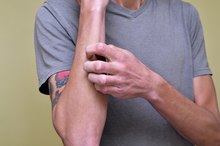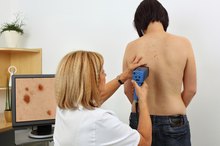What does fact checked mean?
At Healthfully, we strive to deliver objective content that is accurate and up-to-date. Our team periodically reviews articles in order to ensure content quality. The sources cited below consist of evidence from peer-reviewed journals, prominent medical organizations, academic associations, and government data.
The information contained on this site is for informational purposes only, and should not be used as a substitute for the advice of a professional health care provider. Please check with the appropriate physician regarding health questions and concerns. Although we strive to deliver accurate and up-to-date information, no guarantee to that effect is made.
How to Get Rid of Scars From Impetigo
Impetigo is a skin infection most commonly seen in children. It is often the result of poor hygiene in children living in moist, humid climates. According to the Mayo Clinic, the infection causes pus-filled bumps that develop a crusty covering and can lead to scarring 1. Impetigo is highly contagious and usually develops on the upper lip. Pustules typically first appear within four to 10 days after exposure to the bacteria. Impetigo should be promptly treated and covered to prevent passing on the infection and to avoid scratching that can lead to scars.
See a dermatologist or plastic surgeon for a procedure called dermabrasion after you have completely eradicated the impetigo. Dermabrasion is one of the most popular forms of facial scar treatment, according to the American Academy of Dermatology 2. The treatment involves removing the outer layers of scarred skin with a diamond-tip sanding instrument, which also stimulates new skin growth.
How to Get Rid of Stitch Scars on the Face
Learn More
Consider visiting a dermatologist or cosmetologist for a chemical peel, a procedure that utilizes strong chemicals instead of mechanical instruments to remove the scarred layer of skin. According to the American Society of Plastic Surgeons, chemical peels vary in strength, depending on the size of the scar and how much you want to remove 4. Although the more intense peels remove deeper scars, they sometimes result in uneven skin pigmentation in the new skin growth.
Visit a plastic surgeon to get a medical opinion about facial reconstructive surgery 3. The scars from impetigo closely resemble acne scars and do not become larger over time. Plastic surgery may require skin grafts and lengthy recovery time, but it may be the best solution if the scars have hardened and restrict facial movements in any way 3. A number of surgical options are available to remove facial scars; however, most leave some minor residual scarring.
What Is the Difference Between Cellulitis & Mrsa?
Learn More
Undergo laser scar-removal surgery 5. A number of different kinds of lasers can reduce the appearance of impetigo scars that you may have endured since childhood. According to the Consumer Guide to Plastic Surgery, lasers can remove the top layer of skin much like dermabrasion or chemical peels 45. Lasers can also direct the pulses of light to deep underlying layers of skin and heal the scar from the inside out by promoting collagen production to fill in the scarred recesses of the skin.
Tips
According to the American Academy of Facial Plastic and Reconstructive Surgery, facial skin can take up to a year to fully recover after a bout of impetigo. They advise waiting until you are sure natural healing is complete before undergoing any cosmetic procedure or facial surgery to remove the scars.
Warnings
Impetigo facial scars may undermine your self-confidence, especially if you've lived with the scars since childhood. While a surgical procedure may result in a better quality of life for you, the scars typically are not considered medical conditions; the procedures usually are considered cosmetic and are not covered by health insurance, according to the American Academy of Facial Plastic and Reconstructive Surgery.
Related Articles
References
- Mayo Clinic: Impetigo
- American Academy of Dermatology: Facial Skin Rejuvenation
- American Academy of Facial Plastic and Reconstructive Surgery: Facial Scars
- American Society of Plastic Surgeons: Chemical Peels
- Consumer Guide to Plastic Surgery: Laser Scar Removal
- Saint-jean M, Khammari A, Jasson F, Nguyen JM, Dréno B. Different cutaneous innate immunity profiles in acne patients with and without atrophic scars. Eur J Dermatol. 2016;26(1):68-74. doi:10.1684/ejd.2015.2713
- Archer CB, Cohen SN, Baron SE. Guidance on the diagnosis and clinical management of acne. Clin Exp Dermatol. 2012;37 Suppl 1:1-6. doi:10.1111/j.1365-2230.2012.04335.x
- Woolery-lloyd H, Kammer JN. Treatment of hyperpigmentation. Semin Cutan Med Surg. 2011;30(3):171-5. doi:10.1016/j.sder.2011.06.004
- Hedelund L, Haak CS, Togsverd-bo K, Bogh MK, Bjerring P, Haedersdal M. Fractional CO2 laser resurfacing for atrophic acne scars: a randomized controlled trial with blinded response evaluation. Lasers Surg Med. 2012;44(6):447-52. doi:10.1002/lsm.22048
- Hedelund L, Moreau KE, Beyer DM, Nymann P, Haedersdal M. Fractional nonablative 1,540-nm laser resurfacing of atrophic acne scars. A randomized controlled trial with blinded response evaluation. Lasers Med Sci. 2010;25(5):749-54. doi:10.1007/s10103-010-0801-1
- Kim EK, Hovsepian RV, Mathew P, Paul MD. Dermabrasion. Clin Plast Surg. 2011;38(3):391-5, v-vi. doi:10.1016/j.cps.2011.05.001
- Wollina U, Goldman A. Fillers for the improvement in acne scars. Clin Cosmet Investig Dermatol. 2015;8:493-9. doi:10.2147/CCID.S86478
- Fabbrocini G, Annunziata MC, D'arco V, et al. Acne scars: pathogenesis, classification and treatment. Dermatol Res Pract. 2010;2010:893080. doi:10.1155/2010/893080
- Alexiades M. "Laser and Light-Based Treatments of Acne and Acne Scarring." Clinics in Dermatology. 2017 Mar - Apr;35(2):183-189.
- Fife D. "Evaluation of Acne Scars: How to Assess Them and What to Tell the Patient." Dermatologic Clinics. 2016 Apr;34(2):207-13.
- Werschler WP, Few JW, Jacob CI, Joseph JH, Spencer JM, Taub AF. "Advancing the Care of Post-Acne Scarring: Expert Insights Into New Treatment Options." Journal of Drugs in Dermatology. 2016 May 1;15(5):518-25.
- Zaleski-Larsen LA, Fabi SG, McGraw T, Taylor M. "Acne Scar Treatment: A Multimodality Approach Tailored to Scar Type." Dermatologic Surgery. 2016 May;42 Suppl 2:S139-49.
- Zouboulis CC, Bettoli V. "Management of Severe Acne." British Journal of Dermatology. 2015 Jul;172 Suppl 1:27-36.
Writer Bio
Linda Ray is an award-winning journalist with more than 20 years reporting experience. She's covered business for newspapers and magazines, including the "Greenville News," "Success Magazine" and "American City Business Journals." Ray holds a journalism degree and teaches writing, career development and an FDIC course called "Money Smart."








